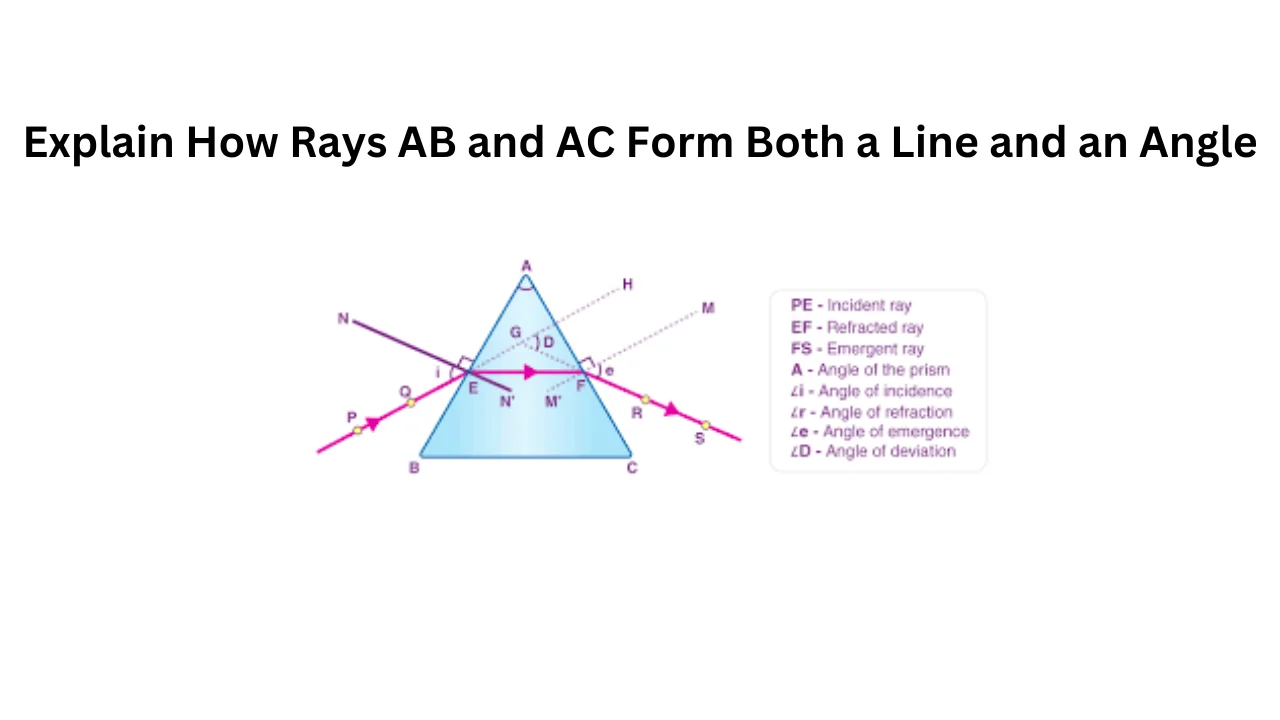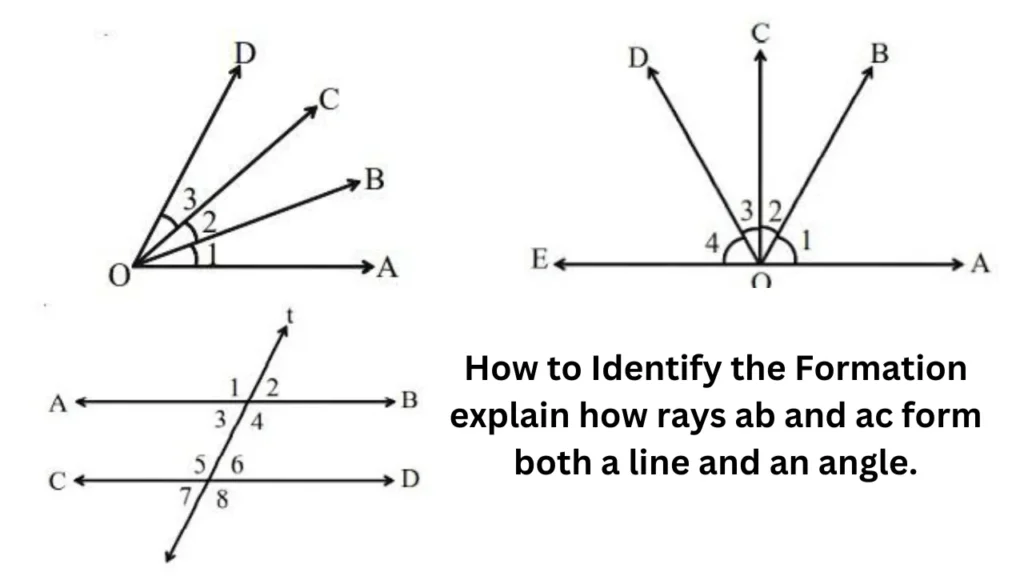Explain How Rays Ab And Ac Form Both A Line And An Angle.

When discussing geometry, it’s essential to understand how different components come together to form shapes and figures. In this article, we will explain how rays AB and AC form both a line and an angle. This concept is fundamental in geometry, helping students grasp how simple elements create complex structures.
What is explain how rays ab and ac form both a line and an angle.
The phrase explain how rays AB and AC form both a line and an angle refers to a geometric concept involving two rays that share a common endpoint. Here’s a brief explanation:
Rays AB and AC Forming a Line:
If rays AB and AC are collinear, meaning they lie on the same straight path but extend in opposite directions from their common endpoint A, they form a straight line. In this scenario, point A is the shared starting point, and points B and C are positioned such that they create a continuous line extending in both directions.
Rays AB and AC Forming an Angle:
When rays AB and AC spread out from point A in different directions, they form an angle. The size of this angle depends on the degree of divergence between the two rays. If the rays extend away from point A at any degree other than 180°, they form an angle measured in degrees.
In essence, rays AB and AC can create both a line and an angle depending on their positions relative to each other and their common endpoint.
Understanding Rays in Geometry
A ray in geometry is a line that starts at a particular point and extends infinitely in one direction. It consists of a starting point, called the endpoint, and a direction in which it moves endlessly. For instance, if you have ray AB, point A is the starting point, and the ray moves infinitely in the direction of point B.
Explain how rays ab and ac form both a line and an angle.
To explain how rays AB and AC form both a line and an angle, let’s first consider how they create a line. For rays AB and AC to form a line, they must be collinear, meaning they lie on the same straight path. This happens when point A is shared by both rays, and points B and C are on opposite sides of A. In this scenario, the rays extend in opposite directions, creating a straight line.
For instance:
| Points | Description |
|---|---|
| A | Common starting point of both rays |
| B | Point in the direction of ray AB |
| C | Point in the direction of ray AC |
If points B and C are aligned in such a way that they form a continuous line with point A in the middle, then rays AB and AC together create a straight line, also known as a linear pair of rays.
Formation of an Angle by Rays AB and AC
Now, let’s move on to how these rays form an angle. An angle is created when two rays share a common endpoint but extend in different directions. The common endpoint is called the vertex, and the two rays are known as the sides of the angle.
In the case of rays AB and AC, if these rays diverge from point A in different directions, they form an angle. The amount of divergence between these rays determines the size of the angle, which can range from 0° to 180° or even more in certain cases.
Visual Representation
To visualize how rays AB and AC form both a line and an angle, imagine placing point A on a piece of paper. Then, draw ray AB extending to the right and ray AC extending to the left. This would create a straight line, representing how the rays form a line.
Now, adjust ray AC so that it points upwards instead of left. This creates an angle at point A. The divergence between AB and AC now measures the angle formed.
| Scenario | Representation |
|---|---|
| Rays form a line | A—B—C |
| Rays form an angle | B |
| \ | |
| A—C |
This table illustrates how adjusting the directions of the rays changes their geometric relationship.
How to Identify the Formation explain how rays ab and ac form both a line and an angle.

To explain how rays AB and AC form both a line and an angle, it’s crucial to identify their configuration:
Line Formation:
If ray AB and ray AC are opposite each other, with point A as their common starting point, they create a straight line. This happens because they are extending in exactly opposite directions, creating a collinear arrangement.
Angle Formation:
If ray AB and ray AC spread out from point A at any degree other than 180°, they form an angle. The size of this angle depends on how far apart the rays diverge from each other.
Practical Applications in Geometry explain how rays ab and ac form both a line and an angle.
Understanding how rays AB and AC form both a line and an angle is not just a theoretical exercise. It has practical applications in various fields:
Architecture:
Designers use the principles of angles and lines to create structures and spaces.
Engineering:
Engineers apply these geometric principles in constructing everything from simple machines to complex infrastructure.
Art and Design:
Artists and designers often use angles and lines to create visually appealing compositions.
Special Cases of explain how rays ab and ac form both a line and an angle.
There are special cases where the relationship between rays AB and AC becomes particularly interesting. For example:
Perpendicular Lines:
If rays AB and AC form a 90° angle, they are said to be perpendicular. This is a common scenario in construction and design.
Supplementary Angles:
When rays AB and AC form a straight line, the angle between them is 180°, making them supplementary.
Understanding these special cases helps further explain how rays AB and AC form both a line and an angle in different contexts.
How to Measure the Angle Formed explain how rays ab and ac form both a line and an angle.
To measure the angle formed by rays AB and AC, you can use a protractor. Place the midpoint of the protractor at point A and align one ray with the zero line of the protractor. The position of the other ray on the protractor scale will indicate the angle between the two rays.
| Steps to Measure Angle | Description |
|---|---|
| 1. Position Protractor | Place midpoint at point A |
| 2. Align Ray AB | Align ray AB with zero line of the protractor |
| 3. Measure Ray AC | Observe where ray AC falls on the protractor scale |
| 4. Read the Angle | Note the angle between the two rays, which is the measure |
This table outlines the simple steps to measure the angle, making it easy to follow even for beginners.
Importance of Understanding Line and Angle Formations
Grasping the concept of how rays form both a line and an angle is foundational in geometry. It provides the basis for understanding more complex shapes and their properties. Moreover, this knowledge is crucial in solving real-world problems that involve measurements, construction, and design.
Frequently Asked Questions
Can rays AB and AC form a straight line?
Yes, rays AB and AC form a straight line if they are collinear and extend in opposite directions from their common endpoint A.
How do rays AB and AC create an angle?
Rays AB and AC create an angle when they diverge from a common point, A, in different directions, forming an angle between them.
What determines whether rays form a line or an angle?
The position and direction of the rays determine their formation. If they are collinear, they form a line; if they diverge, they form an angle.
Conclusion
Understanding explain how rays ab and ac form both a line and an angle. is fundamental in geometry. It highlights how simple elements like rays can create complex structures based on their positions and directions. Whether forming a straight line by being collinear or creating an angle through divergence, the relationship between these rays offers valuable insight into geometric principles. Mastering this concept is essential for grasping more advanced topics in geometry and its practical applications in various fields.






